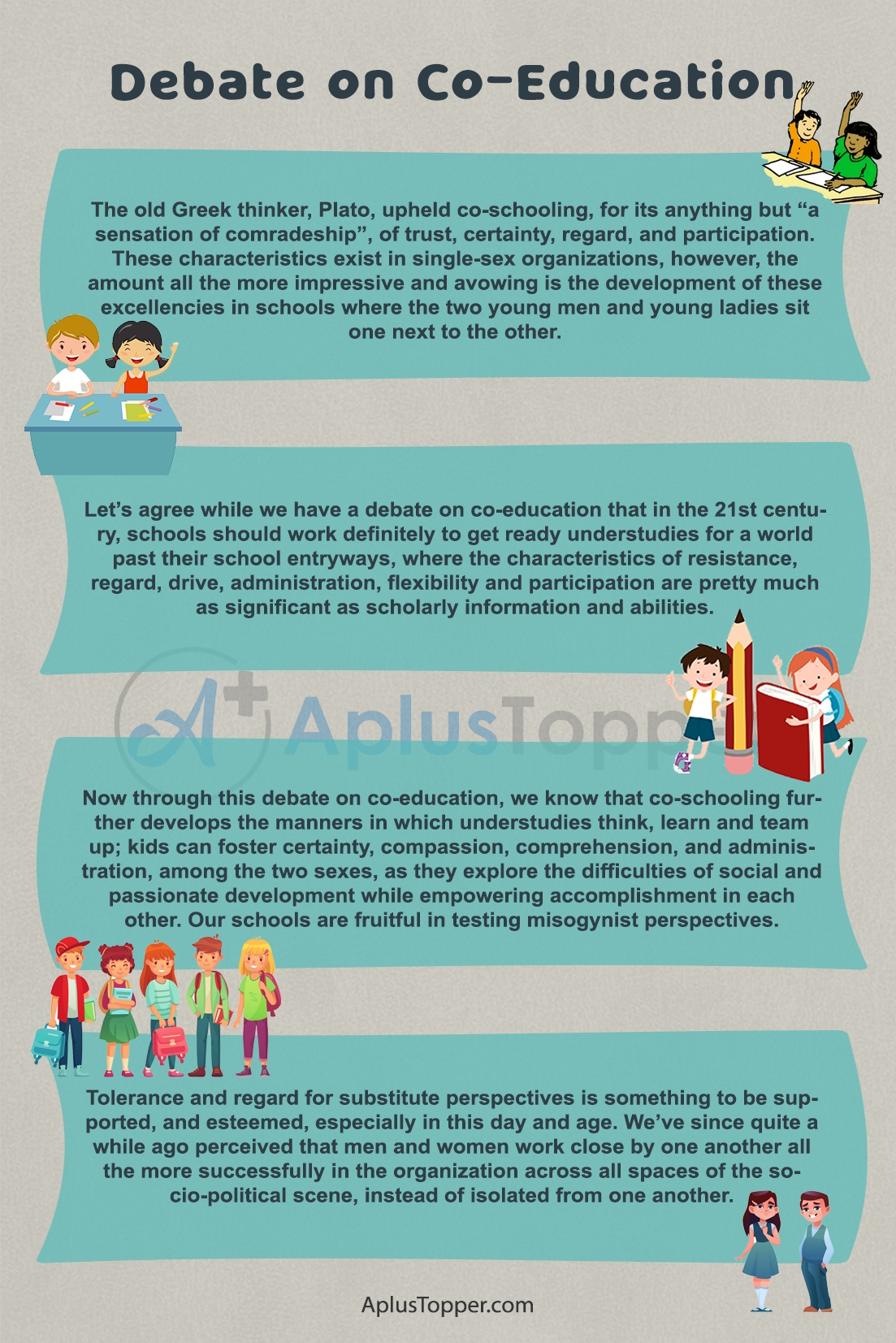Debate on Co-Education: In this debate on co-education, I’m in concurrence with the explanation that co-educational schools are a superior learning environment for kids when contrasted with that of a single-sex school.
Before having a debate on co-education, let’s start with its introduction. In co-education schools, girls and boys, men and women, share in the delight of learning together, creating common regard and comprehension for one another. Young girls and young boys working and learning together in normal settings where sexual orientation fairness and opportunity is advanced, in both scholastic and co-curricular exercises, mirrors the most reasonable and legitimate learning climate.
You can also find more Debate Writing articles on events, persons, sports, technology and many more.
The old Greek thinker, Plato, upheld co-schooling, for its anything but “a sensation of comradeship”, of trust, certainty, regard, and participation. These characteristics exist in single-sex organizations, however, the amount all the more impressive and avowing is the development of these excellencies in schools where the two young men and young ladies sit one next to the other.
Let’s agree while we have a debate on co-education that in the 21st century, schools should work definitely to get ready understudies for a world past their school entryways, where the characteristics of resistance, regard, drive, administration, flexibility and participation are pretty much as significant as scholarly information and abilities. On the off chance that a school’s ethical reason for existing is outlined around planning youngsters for the evolving, unsure world they are to acquire, then, at that point, the education experience ought to mirror the variety and truth of a particular word. There is an excessive amount to be acquired from having youngsters of the two sexual orientations learning next to each other over a maintained and expanded time frame. Cooperating in the homeroom and on schoolwork tasks furnishes young men and young ladies with the chance to gain from one another mentally, just as socially. Young ladies and young men connect cooperatively, trade thoughts, and discuss issues. Significantly the presence of the two sexual orientations adds to the lavishness and variety of reasoning and discovery that fills all study halls in the entirety of our schools, a presence that also penetrates all aspects of society.
Now through this debate on co-education, we know that co-schooling further develops the manners in which understudies think, learn and team up; kids can foster certainty, compassion, comprehension, and administration, among the two sexes, as they explore the difficulties of social and passionate development while empowering accomplishment in each other. Our schools are fruitful in testing misogynist perspectives. Numerous subjects take into account extensive homeroom conversation and discussion; people regularly have alternate points of view on the very issues and that each approach has an incredible arrangement to bring to the table the other.
Tolerance and regard for substitute perspectives is something to be supported, and esteemed, especially in this day and age. We’ve since quite a while ago perceived that men and women work close by one another all the more successfully in the organization across all spaces of the socio-political scene, instead of isolated from one another. Co-instruction is a more regular impression of society; our schools better mirror the variety of our way of life. Co-education schools mirror the world that our youngsters and ladies will live in. Outside the homeroom, young ladies and young men stand one next to the other in administrative roles, esteeming acumen, drive, and duties in each other. They play sports, frequently together, and commend each other’s achievements.
Young men and young ladies are consistently preparing together, and our young men are certifiably supporting their female friends routinely, legitimately, and normally from the sidelines, is a powerful acknowledgment of, and instruction about the equivalent status of ladies’ game. They correspondingly go to outside training camps, work together in the performing expressions through music troupes and dramatization, act in school creations and offer sporting space. They eat together, sing together, love together, discover solace, and back each other.
Co-schooling urges young men to be more open to communicating a feeling, to show lowliness and delicate quality. Exploration additionally proposes that young men can temper the enthusiastic force regularly clear in young ladies’ education establishments, and standardize the power of young ladies’ companion connections.
Fellowships are created characteristically in co-education schools. This happens on the grounds that there are countless exercises, social orders, and clubs in the school in which young ladies and young men partake in a charming, well-supervised climate. Sound fellowships create between sexual orientations through the course of their tutoring, in light of the fact that young men and young ladies share in the victories and the mistakes, the humor, the pity, and the difficulties of youth.
We have agreed in this debate on co-education that young ladies and young men associate with one another as counterparts in all parts of regular school life. In doing so, they assemble a sound stage for self-improvement, peer connectedness, associations with others, and the advancement of proper worthy frameworks.
Co-instruction in immaturity assists with directing and equilibrium sex explicit practices. Co-instruction gives a more practical method of molding youngsters to take their places normally in the more extensive local area of people. It assists with separating the misguided judgments of each sex about the other and gives a great establishment to the improvement of sensible, significant, and enduring connections in later life.
Co-education schools get ready understudies to prevail in present Secondary training and on change to the labor force appropriately ready for the social dynamic. Cooperation among young ladies and young men in the homeroom creates trust in understudies for their life after school, particularly at college, and as the up-and-coming age of pioneers.
Several years prior when Canadian Prime Minister Justin Trudeau was inquired as to why he wanted to have sex equality in his bureau, with people working close by each other as equivalents, supplementing each other’s qualities and deficiencies, he answered basically, “Because it’s 2015.” The world has changed; the jobs and openings for the two people have changed; the conventional money of single-sex organizations has been debased, and the office we wish to give our young men and young ladies is intensified through incorporation and correspondence in the regular, not foundational isolation.
Let us not neglect that through instruction, young men and young ladies, developing young ladies and men, learn not just about the educational plan. They likewise go through almost 15 years finding out about themselves, realizing what their identity is.
So to conclude my debate on co-education, let’s agree that isolating kids for various years implies they won’t blend and find out about one another. One’s comprehension of self is intrinsically molded by the connections framed with everyone around them and a consciousness of how they fit into the texture of their reality. Given this, co-education advances an undeniably more genuine comprehension of one’s self and one’s capability to make important commitments to society as a deferential, tough, and cooperative grown-up.

FAQ’s on Debate on Co-Education
Question 1.
What is co-education?
Answer:
Co-education is a system of education in which students of both sexes receive their education in the same classroom under the same roof. A spirit of healthy competition and cooperation thrives in co-education schools. Most countries have adopted this method of teaching as a means to create a world that thrives to provide equal opportunities to all genders.
Question 2.
Why is co-education better?
Answer:
Co-education provides a holistic growth opportunity for a child and ensures that the child grows with an excellent awareness of his gender and the opposite gender. It helps the child understand the diversity of a community. It also gives the child a platform to understand the environment they will be a part of as adults sharing responsibilities and living life as independent individuals capable enough to support themselves.
Question 3.
What values does co-education impart among young ladies and young men?
Answer:
Co-education imparts values such as trust, confidence, respect for each other, the spirit of cooperation, and also a sense of healthy competition.
Question 4.
How does co-education boost the confidence of students?
Answer:
Students in co-education schools are more confident and comfortable in social situations. They find it easier to make friends from the opposite gender and find it easy to express their opinions in front of the opposite sex.
Question 5.
Why is co-education often criticized?
Answer:
Conservative people of the society with closed minds often criticize the co-education system. Their deep-rooted conservative values tell them that co-education schools are against our customs and traditions. They fear that co-education will develop immoral relations between young ladies and young men.
